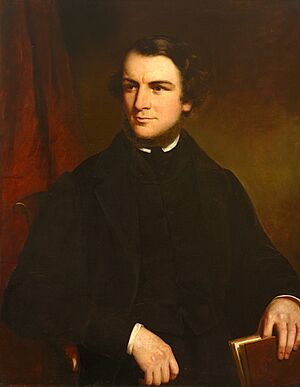John Hulke facts for kids
John Whitaker Hulke (born November 6, 1830 – died February 19, 1895) was a British scientist. He was a skilled surgeon, a geologist, and a collector of fossils. His father was a doctor in Deal, Kent.
Hulke worked with another famous scientist, Thomas Henry Huxley, at the Royal College of Surgeons. He loved collecting fossils from the Isle of Wight cliffs. He studied ancient animals, especially dinosaurs like Iguanodon and Hypsilophodon. These fossils came from rocks formed during the Lower Cretaceous period. Hulke also led important groups like the Geological Society and the Royal College of Surgeons. He even won a special award called the Wollaston Medal in 1888 for his work.
Contents
Early Life and Education
John Whitaker Hulke was born in Deal, Kent, England. His father was a local doctor. John went to a boarding school in England. He also studied at a college in Germany from 1843 to 1845.
While in Germany, he learned German very well. He also became interested in geology by visiting the Eifel region. After returning to England, he attended King's College School. Three years later, he started working at a hospital. He became a qualified surgeon in 1852.
A Career in Medicine and Science
Hulke was a very busy and talented person. He had two main careers: one as a surgeon and another as a geologist.
Serving in the Crimean War
In 1855, Hulke volunteered to help during the Crimean War. He worked as an assistant-surgeon in Smyrna. Later, he served during the Siege of Sevastopol. After the war, he came back home.
Becoming a Skilled Surgeon
Back in England, Hulke became a medical teacher at his old hospital. In 1857, he became a Fellow of the Royal College of Surgeons. He also worked at the Royal Ophthalmic Hospital, Moorfields. He became a surgeon there in 1868.
In 1861, Hulke was the first to describe a skin condition called oculodermal melanosis. Later, in 1870, he became a surgeon at the Middlesex Hospital. He was known for his excellent surgical skills. He was a great general surgeon, but he was especially good at eye surgery.
Discovering Ancient Dinosaurs
Hulke was also a very respected geologist. In 1867, he became a Fellow of the Royal Society. This was for his research on the eye's retina in humans and animals.
After this, he spent all his free time on geology. He was especially interested in fossil reptiles. He described many dinosaur remains found on the Isle of Wight. He had access to a great collection of fossils from Reverend W. Fox.
In 1869, Hulke found a complete Iguanodon braincase. He offered it to Thomas Henry Huxley to study. Huxley was too busy, but he helped Hulke prepare and describe it. Hulke then published many papers about his discoveries. In 1887, he received the Wollaston Medal for his important geological work.
Leading Scientific Societies
John Whitaker Hulke was a leader in many scientific groups. He was president of the Geological Society and the Pathological Society in 1883. He also led the Clinical Society and the Royal College of Surgeons from 1893 until his death.
He was a person with a wide range of knowledge. He knew a lot about science, literature, and art. He published over fifty scientific papers, with 28 of them being about dinosaurs. After he passed away, his amazing fossil collection was given to the Natural History Museum.
Hulke was supposed to give a special speech called the Hunterian Oration in February 1895. But he died just before. Another surgeon, Thomas Bryant, gave the speech for him.


